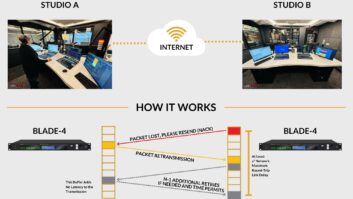Around 1940, when radio was still in its youth, a company proclaiming itself “the fountainhead of modern tube development” introduced a unique electron tube. It was designed to perform multiple functions in a consumer receiver but was eminently qualified for use in broadcast “speech input” and sound reinforcement equipment. The characteristic that set it apart was that it was a pentagrid.
Designated the 6L7, this octal-based tube boasting five grids would, in souped-up form, qualify it for admission to the Radio Corporation of America’s elite broadcast group under the type number 1612. If you’re as old as I, you’ll recall that the popular preamp 6J7 was a broadcast 1620, the 6L6 beam power output tube, still hot (no pun intended) today, a 1614. By the way, RCA’s tube designations were unrelated to the sequence of issuance.
Fig. 1: The VitaVox schematic.
Here you’re going to see how an unknown yet readily available gem can enhance your station’s sound by inexpensively returning to the airwaves — your air — the voice warmth and naturalness of life.

The 6L7 boasts two control-grids, one on pin 5, and the other on a grid-cap — a format that, aided by grid interlacing construction, minimizes coupling between the elements. Because of this, the complex 6L7 requires only seven of the eight pins on its octal base. Old-timers would use Pin 6 on the socket as a handy wiring tie-point. Because the audio input is at Pin 5, shielded wire to the grid-cap would be unnecessary.
Fig. 1 is RCA’s schematic, corrected and with unneeded components eliminated. S1 would appear to switch out high-pass filtering when connection of C6 to C21 is made. Nevertheless, with three .05 mfd capacitors C20, C5 and C21 in series, there would appear to be a bit of low-frequency attenuation remaining.
EASY REMOTE CONTROL
The Master Mixer 1612 is a summing amplifier whose gain is controlled by R14. Because R14 is in the cathode circuit and is a whopping 250 kilohms, you can run 250 feet or so of unshielded wire for master gain remote control with no problem. The same goes for gain control, R4 of each preamp. This means you could locate your amplifier unit in the talk studio or announce booth, controlling gain from as far away as you want. Note that there’s no need to locate R14 remotely because the fader on your consolette becomes your group master gain control. Thus R14 can be preset as desired on the chassis and left as such. Potentiometer noise never becomes a concern in this application.
The 1 megohm “Compansion” control R26 may similarly be remoted. You could even remotely select Expansion or Compression by changing S2 to DPDT relay contacts.
Wanna get cute? Put a switch on the remote-control panel — the unit you’ll be placing near your consolette — for each mic, which grounds the swinger arm on the pot (R4) and you’ll have switch-controlled on-off capability on each individual mic. Caution: There exists the possibility of a “tick” being generated when this switch is operated, for you’ll be connecting or disconnecting a circuit to ground. Moreover, this condition may be aggravated by the long remote-control wires.
Experience has shown that maximum benefits of tube mic preamplifiers are achieved with the absence of solid-state circuitry between the microphone and the tube; further that there are at least two stages of tube amplification. The circuit herein delivers this.
Yet to do so, preamp input transformers are used and they are more costly than the tubes.
Throughout its history, RCA put United Transformer Corp. components in its audio circuitry. UTC ultimately marketed the transformer appropriate here, to anyone as the type O-16, a heavily shielded small package that could be rotated on the chassis to orient it to where hum pickup was at a minimum. Its primary was 250 ohms, the secondary 50k.
INTERUNIT GROUND PROBLEMS ELIMINATED
The audio output from C11 can be sent using the same transformer type, but connected in reverse for plate-to-line usage. The benefit of transformer isolation is that the effect of minor power mains voltage differences between VitaVox™ (my word for this product) and the consolette is eliminated, cable length is immaterial, hum is non-existent.
With the transformer, the line between the output of VitaVox and the consolette input could even be balanced yet (one leg) grounded at the receiving end. In this instance, the signal leaves VitaVox as balanced, but would become unbalanced at its destination. I’d use two-conductor shielded wire with shield grounded at the receiving end. If you want to keep the audio output balanced, you’ll need an appropriate input transformer at the consolette.
To retain a semblance of balance and avoid a transformer at the destination, insert an H-pad there, grounding one leg of its output.
The compander section gets audio from the preamplifiers’ combined outputs, passing it to the two diodes manifested in the 6H6. Not to worry; there are solid-state diodes to be substituted for this valve. There also are fine, current-manufacture audio transformers that have O-16 characteristics. Moreover, please plan to use a power supply that not only provides 300 VDC plate supply power but delivers 6 VDC to the filaments. Via the latter, hum is reduced and the 6 volts being DC and less than 6.3 guarantees untold years of tube life.
Ready to start construction? Here’s how to get the resistor and capacitor values you need. Send me an email at[email protected], and I’ll be delighted to send you the parts data with my compliments. Included will be the circuit incorporating the components for replacing the 6H6 with solid-state diodes. I’ll also tell you where to get the transformers, power supply components and, above all, the electron tubes. My pleasure. May the benefits of VitaVox inure to you and yours. That’s the sound of life.
Thanks to vacuum tube ace M.E “Mitch” Margolis for his guidance.
The author is grandson of Emile Berliner, inventor of the microphone, gramophone (disc records player) and the method of mass-producing unlimited copies of a single master disc recording. Oliver began his career at age 16 at Beverly Hills High School where the product described here was in use; he has designed recording facilities, radio broadcast equipment and commercial sound systems, and owned an FM station. In the 1970s, he created a low-cost TV waveform monitor, vector monitor and pulse-cross monitor that led to versions by Panasonic, Leader, Electrohome and Hitachi.












